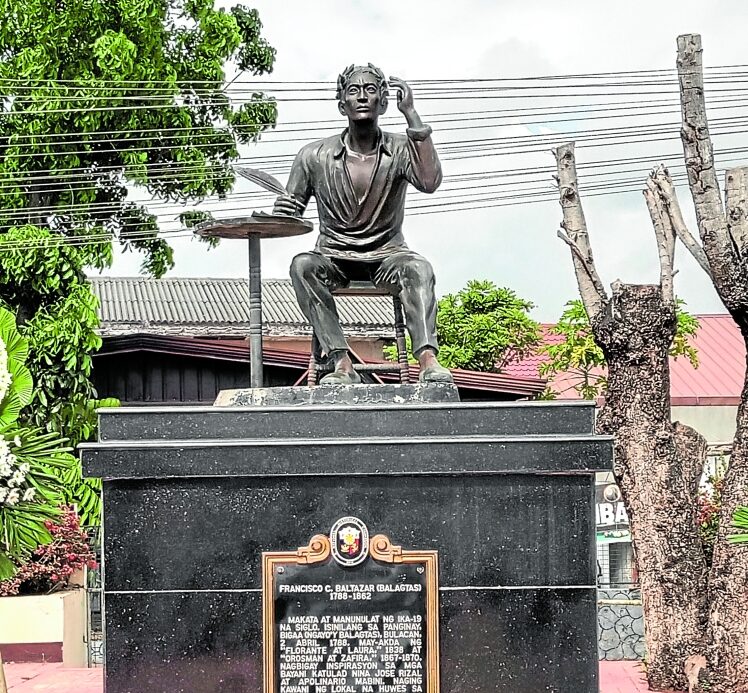‘Florante at Laura’ as tool for unity

Francisco Baltazar, better known as Balagtas, arguably the foremost Filipino poet in any language, was imprisoned twice in his lifetime. A Bulakeño, Kiko Balagtas moved to Pandacan, Manila, as a young man and soon fell in love with a local beauty, Maria Asuncion Rivera. Alas, he had a rival, the rich and influential Mariano Capule, who had him imprisoned on false charges.
In prison, Balagtas, in true literary tradition, wrote his masterpiece, “Florante at Laura,” an awit (metrical romance) which is one of the glories of Philippine literature in any language. He was released in 1836, after which he published “Florante at Laura.”
He moved to Balanga, Bataan in 1840 and worked in the court of the Justice of the Peace, and married Juana Tiambeng in 1842. The couple had 11 children but only four survived.
In Bataan, Balagtas was imprisoned again in 1856 on charges that he ordered a housemaid’s head be shaven. Released in 1861, he continued writing poetry and translating Spanish documents, and died in 1862 in Udyong (Orion), Bataan at the age of 74.
Much of what we know about Balagtas’ life and works may be due to the scholar, poet, and labor organizer Hermenegildo Cruz, who listed down Balagtas’ works and recreated some of his plays as memorized by the poet’s surviving children, whom he interviewed. Five of Balagtas’ plays are considered lost and the major works that have come down to us, apart from the celebrated “Florante at Laura,” include “Orosman at Zafira,” a komedya (what used to be called moro-moro) which has been staged twice on Manila stages, and “La India Elegante y El Negrito Amante.”
Tribute to the poet
April 2 was the 237th birth anniversary of the poet, Balagtas Day, and a tribute to the poet, organized by the National Commission for Culture and the Arts (NCCA) was held in the seaside town of Orion, Bataan. The activity was part of National Literature Month.
Speakers focused on the lessons to be learned from “Florante at Laura,” with its famous beginning in which Florante is tied to a tree and is menaced by a lion. Briefly, the epic tale is about Florante and his beloved Laura, Christians who struggle against the camp of the treacherous Adolfo (who covets Laura) and team up with Aladin and Flerida, Muslims, to bring peace to their respective kingdoms of Albania and Persia.
Governor Jose Enrique Garcia III said Balagtas was “one of the few who continued to write in Tagalog (during the Spanish era). Above all he stood for unity (magpakaisa). He was not for just one generation but for all generations.”
For Mayor Antonio Raymundo Jr., “Balagtas wrote about the truth of his time, the exploitation (pang-aapi). ‘Florante at Laura’ is not just a love story, it is a story of love of country.”
Arthur Casanova, president of the Komisyon ng Wikang Filipino, said that “despite hardship, Balagtas continued to write. ‘Florante at Laura’ should serve as an inspiration for all Filipinos, and we should read this masterpiece. In this work, life is a struggle, but there is also faith in God.”
Tourism officer Danica Lolita Tígas also mentioned hardship: “In the face of hardship there is hope, that is one lesson from this book. We can see that, for Balagtas, it is important to write a story, and also that every Filipino can be brave.”
Representing the NCCA, Bernan Joseph Corpuz said, “Culture is a tool in developing our country. We have the power and richness of our culture. Literature gives us our identity. We should enrich this and bring it to the attention of the world.”
Balagtas was born in Bigaa (now Balagtas), Bulacan on April 2, 1788 and died in Bataan, and that is why he is claimed by both Bulacan and Bataan. But the truth is that he belongs to the Filipino nation, and not just to one or two provinces.

















